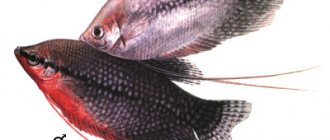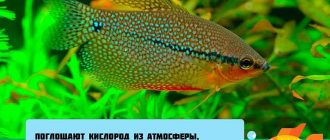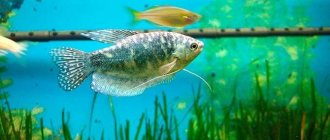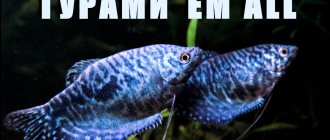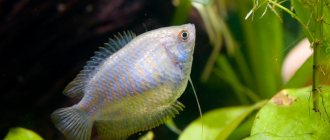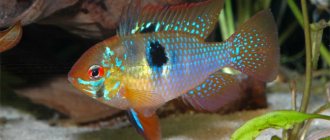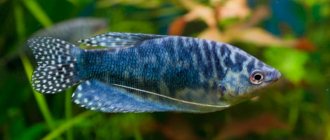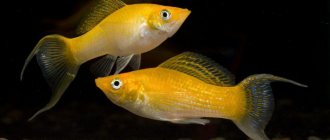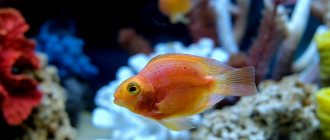External characteristics of the type
Marbled Gourami have an elongated, flattened body. On its surface there are fins that are large relative to the size of the individuals. The pelvic fins look like antennae, thanks to which the gourami evaluates its surroundings. There are receptors on the fins that sense minute changes in temperature and also react to approach.
Since the fish represents the Labyrinth family, the marbled gourami inhales the oxygen of the atmosphere, and with this feature it has the ability to live with a small amount of oxygen.
The fish is painted in bright colors; during spawning, the male is even brighter. The scales are dark blue with spots that are randomly located and look like shades of marble. The specimen itself is large, so it must be kept in a spacious aquarium.
The individual lives up to 6 years if constantly and properly cared for.
Features of using marble chips for aquariums
An aquarium is an elegant piece of furniture that will diversify your home or office environment. Today, this miniature picturesque sea world can be seen not only in private households, but also in public institutions - clinics, restaurants, offices, shops. An aquarium with beautiful colorful fish and themed decor will perfectly relieve a tense work environment and help you redirect your attention and concentrate.
One of the most important elements of aquariums is soil. Properly selected, it is very important for maintaining the normal functioning of the inhabitants and creating an overall composition.
Sand, gravel, and natural stones can be used as soil. One of the most attractive options is marble chips. The naturalness of the shades of the breed emphasizes the natural coloring of the aquarium. This stone has been used in this area for quite a long time and is deservedly popular among many aquarists.
Properties of marble chips
Marble is a crystalline, granular rock formed from limestone and dolomite. Widely used in construction and decoration, where it has become popular due to its combination of high strength, durability and magnificent appearance. It is the appearance that attracts the attention of aquarists - white, black, pink marble becomes the decoration of any aquarium, giving it originality and harmony. The richness of the natural shades of the rock, like nothing else, is relevant for aquariums in which the use of painted stones is unacceptable. However, some features of marble force one to be more careful in its use when arranging an aquarium - the rock increases water hardness. This is unacceptable for some fish and plants, so before choosing marble soil, you need to make sure that your pets are suitable for hard water.
Types of fish that are well suited to marble soil
Observations show that it is not so much the hardness itself, but sudden changes in this indicator that have a bad effect on the health of the fish, so it is better to avoid completely replacing the existing base with marble. Angelfish, neons, zebrafish, catfish, cichlids, and among plants - anubias are not afraid of increased water hardness. If your fish require soft water, but you still want to decorate the aquarium with marble, you can not completely replace the soil, but build stone islands. In this case, the composition of the water will change very slightly, and any species of fish and plants will be able to live and reproduce comfortably in it.
Habitat in nature
Since the marbled gourami is an artificially bred fish, it cannot be found in the natural environment. But the ancestor, the blue gourami, whose distinguishing features are invisible, is found in the Asian part of the planet. Can be seen in lowlands. Prefers still and slow waters. Chooses a place without a current, but with a large number of plants.
During the rainy season, it moves from rivers to floods, and returns in dry times. Under natural conditions, the fish eats insects and plankton.
The history of the aquarium species begins with the breeding of the Blue Gourami fish by breeder Cosby. At first, the marbled gourami was called by the man’s surname, but later acquired its modern name.
Diseases of marbled gourami
Poor conditions in the aquarium and improper nutrition can cause disease in marbled gouramis . In an aquarium, the most common diseases are: Lymphocystosis. Characteristic signs: open wounds, grayish nodules and flat black growths surrounded by swelling. The fish looks like it has been sprinkled with semolina. Pseudomonosis. Characteristic signs: dark spots on the body, turning into reddish ulcers. Often accompanied by a secondary infection with saprolegniosis. Aerosomon. Infection often occurs from food in overcrowded home aquariums, primarily affecting weakened individuals. Characteristic signs: raised up scales, inactivity, refusal to feed, swollen abdomen with bruises. To avoid these troubles, proper care and nutrition should be provided.
And finally, one useful piece of advice on how to choose healthy marbled gourami . Their color, when purchased, does not play a decisive role, since in the conditions of a commercial aquarium in a pet store, the fish are usually “stressed” and do not shine with bright colors. The main thing is to pay attention to the condition of the fins; they should be straightened, not frayed or cut, and the abdominal threads should be long. Short or broken, indicate either vitamin deficiency or chronic poisoning of fish with toxic products contained in the water. Such specimens, even if they find themselves in good conditions, will feel unwell and grow poorly for a long time.
When transporting labyrinth fish, it is recommended to fill the water-free space in the bag with air rather than pure oxygen, since the latter can burn the delicate respiratory organs of the fish.
Marbled gourami will be an ideal choice for aquarists who do not tolerate unnecessary fuss and tense conflicts in the aquarium. They calmly swim around the aquarium, pecking at algal growths, while practically not damaging the plants themselves.
But in general, marbled gourami are unpretentious, peaceful, interesting ornamental fish that even a beginner can keep.
Marbled gourami: content
Keeping fish is easy. First, you should get 5-6 young individuals and place them in an aquarium of up to 50 liters. The lid of the aquarium should not close tightly, the distance to the water should be 5–9 cm; the fish need atmospheric breathing.
The temperatures in the aquarium and the room should be similar, since breathing cold air makes the fish sick.
As time passes, individuals should be moved to a larger location. This species is adapted to heat, accustomed to the climate of Asia, which means the temperature should be above 24 degrees.
Moderate filtration is needed. There is a need for aeration if there are other fish in the neighborhood. If gourami live separately, it is not necessary. In such a situation, you need to replace a fifth of the water after a week.
Light is needed in the upper part of the aquarium, but the morning sun should not penetrate into it.
To make the fish visible, use pebbles, coarse sand or granite chips as soil. Plant plants in it, first placing them along the edges of the space.
If breeding is planned in the future, then you need to add floating plants. They are used to create a nest. And also add a decorative structure in which gourami like to hide.
Maintenance and care
| Aquarium habitat level | °C | Breeding temperature °C | Total hardness (°dGH) | PH |
| all levels | 22.8-27.8 | 26 | 5-35 | 6-8.8 |
Marbled gouramis swim throughout the entire water column of the tank. If young individuals can still be kept in 55-75 liters, then adults need at least 130 liters or more. It is advisable to keep the aquarium in a room with an air temperature close to the water temperature in the aquarium to avoid damage to the labyrinthine organ. The aquarium must have effective filtration with low water flow - this fish will be disturbed by strong currents, especially in a small aquarium.
You can fully appreciate the colors of gourami on a dark substrate or dark ground and a dark background. The aquarium should be designed so that dominant and calm fish live happily together. To do this, it would be good to plant the aquarium densely with vegetation, add floating plants and make several shelters. This species is very fond of floating plants, but do not forget that not the entire surface of the aquarium should be covered with them - the fish must have access to the surface to swallow air.
Although the marbled gourami has a labyrinth organ and is therefore an extremely hardy fish that can live in water depleted of oxygen, this does not mean that it does not need water changes in the aquarium. The marbled gourami's tissues will suffer from accumulated toxins in the water just like any other fish. Therefore, regular water changes in the aquarium are mandatory - 25% once a week.
Compatibility
Gourami fish is non-conflict and peaceful. Gets along in a community aquarium with similar species. Read more about who is best to live with.
- Can easily get along with neons, minors, angelfish and similar species.
- You should not house with swordtails and Sumatran barbs.
- The fish do not get along with cichlids, parrots, goldfish and similar species.
- Gourami are dangerous for small fish because they can mistake them for food.
Within the species, there are frequent cases of conflicts between males, but this is not dangerous. To prevent this from happening, a pair of fish, or two females and a male, are housed together. If the male is not alone, then it is better to add more vegetation and shelters so that weak individuals hide.
Reproduction of marbled gourami
Two weeks before spawning, males and females are seated in different containers (at the rate of 12 liters per individual). Every day, replace 10% of the water with fresh water. During the entire pre-spawning period, future breeders are fed abundantly and variedly three times a day. The diet must include live bloodworms, coretra, green peas and spinach. Any uneaten remains should be removed immediately. The female's readiness to spawn is determined by her rounded belly.
The stimulus for spawning is an increase in temperature to 26-30 ° C and a decrease in the total hardness of water to 4-10 ° dH (which in most cases can be achieved by boiling water), such an indicator as pH should be at the level of 6-7 units.
As a spawning tank, you can use an aquarium with a volume of about 40 liters, filled with boiled tap water at a temperature of 24-26 ° C, preferably without soil, with riccia floating on the surface and a bush of Java moss in one of the far corners. The water level in the spawning tank should be about 25 cm.
First, the male is placed in the spawning tank (preferably in the morning), and after 10-12 hours (in the evening), the female is placed next to him.
To avoid disturbing manufacturers, it is recommended to cover the sight glass with paper or cloth.
The air compressor and filter, if any, should be turned off, otherwise the flow of water they create will interfere with the construction of the nest; their operation can be resumed after the fry have swam.
On the surface of the water, the male builds a rather sloppy nest of foam, often strengthening it with floating plants. The structure he builds can rise 3 cm above the surface and have a diameter of up to 25 cm. The larger the nest, the more larvae there will be. A small nest indicates the inexperience of the male.
During this period, he often chases the female, who hides from him in the thick of the plants. After completion of construction, which takes approximately 1-1.5 days, mating games begin. The male acquires the brightest color possible, from time to time spreading his fins in front of his partner, inviting her to the built nest. There is an assumption that females secrete sex pheromones, thanks to which the male is able to distinguish a mature female from an immature one.
The female, ready for spawning, swims up to the nest and settles down under it; seizing the moment, the male clasps her with his body, squeezing out a portion of eggs, which he immediately fertilizes. Spawning lasts from 1 to 4 days.
Marbled gouramis are capable of spawning 3-6 times per season with a frequency of 2-3 weeks.
Data on the fertility of gourami vary, some sources indicate numbers from 300 to 1000 eggs, others over 2000. On average, a female marbled gourami lays about 500 eggs. Moreover, there is a relationship between the mass of the female and the amount of eggs she lays.
Marbled gourami eggs have positive buoyancy and, once in the water column, tend to float to the surface. The male collects them with his mouth and places them in the middle of the nest. It is often difficult to see the eggs in the nest, since they have almost the same diameter as the air bubbles that make up the nest. But the eggs have a dark golden or brownish tint. Despite the fact that there is quite a lot of caviar, not all fry manage to survive.
As with other members of the genus, the male takes charge of guarding the nest and caring for the eggs.
As soon as the eggs are laid, the female must be removed from the spawning area, otherwise the male may kill her.
Depending on the temperature, the incubation period lasts 1-3 days, and after another three days the larvae turn into fry and begin to swim. As soon as the fry have swam, the male should be removed, otherwise in his attempts to return them back to the nest, he may eat or injure part of the brood.
The water level is reduced to 5-10 cm and maintained until the fry have formed a labyrinthine organ. It is very important to saturate the water with oxygen during this period, since the fry have not yet developed an additional respiratory organ. After the fry begin to gasp for air as they rise to the surface, the water level can be gradually increased as the fry grow.
Starter food for marbled can be ciliates, “live dust”, rotifers or microworms. In the absence of which, you can use hard-boiled egg yolk. The fry are fed 3-4 times a day.
After a few days, the grown fry can be transferred to Artemia nauplii or nematodes. When feeding the fry with dry food, the percentage of deaths increases. To remove the remains of dry food, you can place several coil snails in the nursery aquarium.
The growth of juveniles is very uneven. Because of this, cannibalism flourishes among the fry, when large fry eat their smaller brothers. Therefore, to obtain the maximum number of juveniles, as they grow, they should be periodically sorted.
Golden gourami
To a large extent, the growth rate of marble gourami is influenced by the quality of water. Increasing the level of nitrates and nitrites greatly reduces the rate of their development.
Marbled gourami are capable of forming hybrids with pearl gourami (Trichogaster leeri).
Marbled gourami: reproduction
Marbled gouramis are easy to propagate. The male creates a nest from foam and saliva. The fry develop there.
Propagates in a space of 80 liters. Level up to 15 cm, temperature 27 degrees. They reproduce better when eating live food twice a day.
When the female is ready to produce eggs, the abdomen becomes rounded. Requires shelter. When the nest is ready, the male shows coloration and invites the female to the nest. He provides assistance by pressing against the abdomen. The eggs weigh little, so they float to the top. The process produces 700–800 eggs.
Once completed, the female is relocated. The male takes care of the cubs independently. After a few days the fry hatch. After they swam, the father was moved too. Babies are fed ciliates and worms.
Reproduction
Fish of the described species reach sexual maturity at 6-8 months. During the spawning period, they need to be provided with complete rest, as at this time they are very shy. Experienced aquarists advise covering even the sight glass. Similarly with most labyrinths, the marbled gourami reproduces through nesting.
This process requires a separate spawning aquarium, which should be quite spacious (about 50 liters per couple) with a large amount of vegetation, including on the surface of the water, and a wide water surface. The male marbled gourami builds a nest from foam (air bubbles held together by saliva), usually somewhere in the corner. And the female, plump from caviar, is preparing for spawning.
The selected pair is placed in a prepared spawning tank, which must be at least 50 liters in volume. The water level in it is lowered to 15 cm, and the temperature is maintained from +26 to +27 ° C, which is slightly higher than usual. At the same time, water hardness decreases to 10 dH, and acidity remains at around 7.
During nest building, the male and female marbled gouramis may behave in unusual ways. The male will probably chase his girlfriend, so it is necessary to create conditions for her so that she can hide.
After construction is completed, the fun begins. The male acquires a more saturated and bright shade. He pursues his chosen one, straightening his fins, thereby trying to look most attractive to her. When the female feels that she is ready, she swims up to the nest, and he hugs her, squeezing out the eggs, thereby helping to lay eggs, and inseminates her.
Light eggs easily float directly into the nest. The female is capable of laying up to 800 eggs at a time. Reproduction of the marbled gourami is stimulated by feeding live food twice a day. Then the female is removed, since the male may well kill her. And the father takes care of the brood alone. At this point, it is very important to maintain the temperature at least 27 ° C, otherwise the father will kill his offspring.
